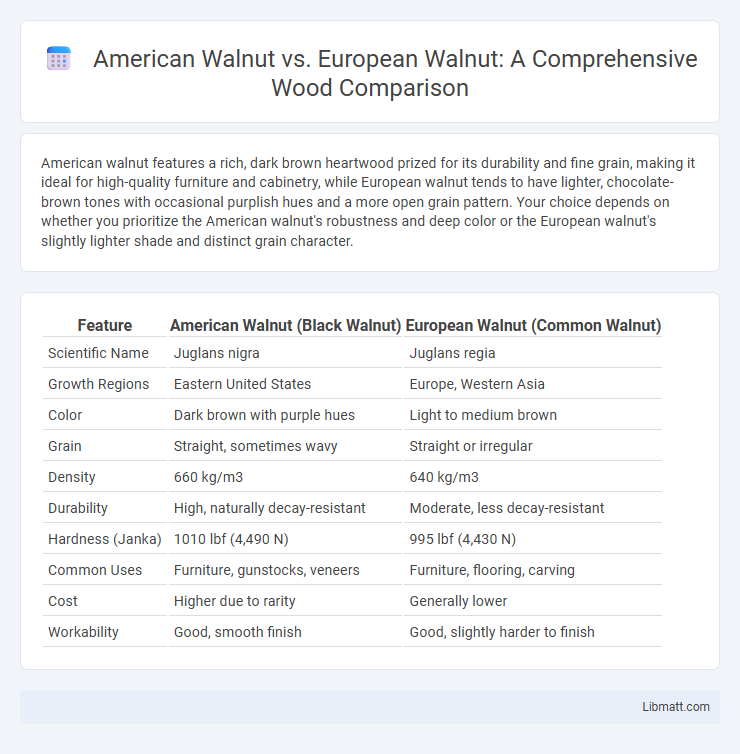American walnut features a rich, dark brown heartwood prized for its durability and fine grain, making it ideal for high-quality furniture and cabinetry, while European walnut tends to have lighter, chocolate-brown tones with occasional purplish hues and a more open grain pattern. Your choice depends on whether you prioritize the American walnut's robustness and deep color or the European walnut's slightly lighter shade and distinct grain character.
Table of Comparison
| Feature | American Walnut (Black Walnut) | European Walnut (Common Walnut) |
|---|---|---|
| Scientific Name | Juglans nigra | Juglans regia |
| Growth Regions | Eastern United States | Europe, Western Asia |
| Color | Dark brown with purple hues | Light to medium brown |
| Grain | Straight, sometimes wavy | Straight or irregular |
| Density | 660 kg/m3 | 640 kg/m3 |
| Durability | High, naturally decay-resistant | Moderate, less decay-resistant |
| Hardness (Janka) | 1010 lbf (4,490 N) | 995 lbf (4,430 N) |
| Common Uses | Furniture, gunstocks, veneers | Furniture, flooring, carving |
| Cost | Higher due to rarity | Generally lower |
| Workability | Good, smooth finish | Good, slightly harder to finish |
Overview: American Walnut vs European Walnut
American walnut (Juglans nigra) features darker, richer wood with a deep brown color and tight grain, prized for high-end furniture and cabinetry. European walnut (Juglans regia) typically presents lighter hues and a more varied grain, preferred for decorative veneers and intricate woodworking. Both types offer excellent durability but differ in aesthetic appeal and availability, influencing choice based on project requirements and regional sourcing.
Botanical Differences
American walnut (Juglans nigra) is native to eastern North America and features darker, richer heartwood with a coarse grain, while European walnut (Juglans regia), originating from Central Asia and Europe, has lighter heartwood and a finer, more uniform grain pattern. The leaflets of American walnut are generally larger and more numerous compared to the smaller, fewer leaflets of European walnut. Botanically, American walnut trees grow taller and produce larger nuts with thicker shells, whereas European walnut trees tend to have a shorter stature with smaller, thinner-shelled nuts.
Geographical Origins
American walnut (Juglans nigra) originates primarily from the eastern United States, particularly regions extending from New York to Florida and west to Texas and Minnesota, thriving in temperate hardwood forests. European walnut (Juglans regia), also known as the Persian walnut, is native to a broader area spanning southeastern Europe, the Middle East, and parts of Asia, favoring milder climates with well-drained soils. These distinct geographical origins influence their growth patterns, wood characteristics, and adaptability to different environmental conditions.
Wood Color and Grain Patterns
American walnut displays a rich, dark chocolate brown color with occasional purple hues, while European walnut tends to feature a lighter, more golden brown tone with subtle grey undertones. Grain patterns in American walnut are typically straight with occasional waves and curls, creating a bold and dramatic appearance. European walnut often exhibits a finer, more uniform grain with intricate swirls and tight grain patterns, lending a delicate and elegant aesthetic to wood projects.
Hardness and Durability
American walnut, known for its medium hardness with a Janka rating around 1,010, offers good durability for furniture and flooring but is slightly softer compared to European walnut, which typically rates closer to 1,100 on the Janka scale. European walnut's density grants it enhanced resistance to dents and wear, making it a preferred choice for high-traffic areas and long-lasting wood products. Selecting the right walnut depends on your specific project needs, balancing aesthetic appeal with hardness and durability requirements.
Common Uses in Woodworking
American walnut is highly prized in woodworking for its rich, dark color and straight grain, making it ideal for fine furniture, cabinetry, and gunstocks. European walnut, while slightly lighter and less dense, is favored for decorative veneers, musical instruments, and intricate carvings due to its uniform texture and workability. Your choice between these walnut types depends on the desired aesthetic and functional qualities for your woodworking project.
Price and Availability
American walnut, primarily sourced from black walnut trees (Juglans nigra), generally commands higher prices due to its rich, dark color and dense grain, making it highly sought after in luxury woodworking. European walnut, mainly derived from Juglans regia, tends to be more widely available and affordable, benefiting from extensive cultivation across Europe and better supply chains. Market availability for American walnut is often more limited, contributing to its premium cost compared to the more abundant and cost-effective European walnut.
Workability and Finishing
American walnut exhibits excellent workability due to its medium density and straight grain, allowing for smooth sanding and precise carving with hand or machine tools. European walnut, while slightly harder and denser, offers a finer, tighter grain that responds well to detailed finishing techniques, enhancing durability and promoting a polished, uniform surface. Both types accept stains and finishes well, but American walnut's lighter color often requires less prep to achieve a rich, even tone.
Sustainability and Environmental Impact
American walnut typically grows naturally in managed forests, promoting biodiversity and reducing the need for intensive farming practices, which supports better sustainability. European walnut cultivation often involves more controlled plantations, which can lead to higher yields but may involve greater water usage and soil impact. Choosing American walnut for your projects may contribute to a lower environmental footprint due to its closer alignment with natural ecosystems.
Choosing the Right Walnut for Your Project
American walnut, known for its rich, dark chocolate hues and straight grain, provides excellent durability and workability, ideal for furniture and cabinetry requiring a luxurious finish. European walnut offers lighter tones with intricate grain patterns, making it a preferred choice for decorative veneers and sculptural woodworking where aesthetics are paramount. Your choice between American and European walnut should consider the wood's hardness, color, and grain to match the functional and visual demands of your project.
American walnut vs European walnut Infographic

 libmatt.com
libmatt.com